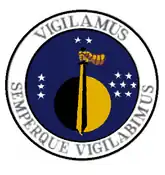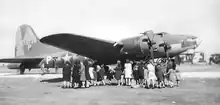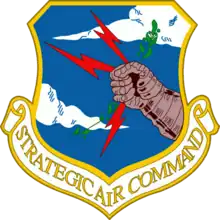| 327th Bombardment Squadron | |
|---|---|
.jpg.webp) B-52 Stratofortress, last plane flown by the squadron[note 1] | |
| Active | 1942–1946; 1946–1963 |
| Country | |
| Branch | |
| Role | heavy bomber |
| Motto(s) | Vigilamus Semperque Vigilabimus (Latin for 'We are Watchful, and We Shall Always be Watchful') (1962-1963) |
| Engagements | European Theater of Operations Korean War[1] |
| Decorations | Distinguished Unit Citation Air Force Outstanding Unit Award Korean Presidential Unit Citation[1] |
| Insignia | |
| 327th Bombardment Squadron emblem[note 2][1] |  |
| Original 327th Bombardment Squadron emblem[note 3][2] |  |
| World War II fuselage code[2] | UX |
The 327th Bombardment Squadron is an inactive United States Air Force unit. It was last assigned to the 4170th Strategic Wing, stationed at Larson Air Force Base, Washington. It was decommissioned on 1 February 1963.
History
World War II
Initial organization and training
The squadron was activated at Barksdale Field, Louisiana on 1 March 1942, as the 327th Bombardment Squadron, one of the four original squadrons of the 92nd Bombardment Group. Later that month it moved to MacDill Field, Florida and trained with Boeing B-17 Flying Fortresses. While training in Florida, the squadron also flew antisubmarine patrols off the Florida coast.[1][3] The squadron's air echelon departed Sarasota Army Air Field for Westover Field, Massachusetts on 19 June 1942, flying on to Dow Field, Maine on 29 June. The squadron then ferried their B-17s across the North Atlantic via Newfoundland starting between 12 and 15 August. They flew directly from Newfoundland to Prestwick Airport, Scotland. The 92nd Group was the first to fly their bombers non-stop across the Atlantic.[note 4][4] Meanwhile, the ground echelon left Bradenton on 18 July, arriving at Fort Dix, New Jersey in the New York Port of Embarkation two days later. It sailed aboard the USS West Point (AP-23) on 2 August and docked at Liverpool on 18 August, moving to Bovingdon the same day.[1][4]
Operations in the European Theater
The buildup of Eighth Air Force in England required the establishment of a combat crew replacement and training center, but a lack of qualified personnel and aircraft hampered its development. As a result, the decision was made to use the 92nd Group and its squadrons as a temporary crew training unit, acting as the main component of what became the 11th Combat Crew Replacement Center Group. However, the 92d was the first group to arrive in England with improved B-17Fs, and with the training mission came an exchange of these newer models for the older B-17Es of the 97th Bombardment Group to use in training. On 6 September, to provide the squadron with combat experience, it flew its first combat mission against the Potez aircraft factory at Meaulte, France.[5][6] Although remaining a replacement crew training unit until May 1943, the squadron initially flew occasional combat missions. In January 1943, he squadron moved to RAF Alconbury.[1]

In 1942 and 1943, there were no fighters capable of escorting bomber formations on deep strike missions. The Army Air Forces tested heavily armed bombers to act as escorts and protect the bomb-carrying aircraft from enemy fighters.[7] As it ended its training duties, The 327th became the only squadron to be equipped with the experimental Boeing YB-40 Flying Fortress gunship[4] from May through July 1943. Twelve of the YB-40s were dispatched to Alconbury for testing and evaluation. The first operational YB-40 sortie took place on 29 May 1943[7] against submarine pens at Saint-Nazaire, France.[6] Very early on, it was found that the additional drag of the turrets and the extra weight of the guns, armor, and additional ammunition reduced the speed of the YB-40 to a point where it could not maintain formation with the standard B-17s on the way home from the target once they had released their bombs.[7] The YB-40 could protect itself fairly well, but not the bombers it was supposed to defend. Consequently, the surviving YB-40s were converted back to standard B-17F configuration or used as gunnery trainers back in the United States. The squadron ended YB-40 operations after fewer than 10 missions[7] on 29 July 1943.[6]

In May 1943, the squadron's training mission was transferred and the 327th began flying combat missions. Through May 1944 its targets included shipyards at Kiel, ball bearing plants at Schweinfurt, submarine pens at Wilhelmshaven, a tire manufacturing plant at Hannover, airfields near Paris, an aircraft factory at Nantes and a magnesium mine in Norway.[3]
The squadron earned a Distinguished Unit Citation (DUC) on 11 January 1944, when it successfully bombed aircraft manufacturing factories in Oschersleben Germany despite adverse weather, a lack of fighter protection and heavy flak.[3][6] It participated in Big Week, the intensive attack against German aircraft industry in late February 1944. It took part in Operation Crossbow, attacks on launch sites for V-1 flying bombs and V-2 rockets. It struck airfields and industrial sites in France, Belgium, the Netherlands, and Germany. After October 1944 it concentrated on transportation and oil industry targets.[3] On 11 September, it earned a second DUC for a mission against petroleum facilities at Merseburg.[1][6]
In addition to its strategic bombing mission, the squadron flew interdiction and air support missions. During Operation Overlord, the Normandy invasion, it attacked coastal defenses, transportation junctions and marshalling yards near the beachhead. It provided air support for Operation Cobra, the Allied breakout at Saint Lo, It bombed bridges and gun positions to support Operation Market Garden, the airborne attacks in the Netherlands near Arnhem, to secure bridgeheads across the Rhine in September. During the Battle of the Bulge, from December 1944 to January 1945, it attacked bridges and marshalling yards near the target area. During Operation Varsity, the airborne assault across the Rhine, it provided cover by bombing airfields near the drop zone.[3] It flew its last combat mission on 25 April 1945, when the 92nd Group led the entire Eighth Air Force formation in an attack on Plzeň.[4][6]
Following V-E Day, the squadron moved to Istres Air Base, France, where it participated in the Green Project, transporting troops returning to the United States, flying them to Cazes Field in Morocco until September, returning French servicemen to France on return trips.[3][4] During the winter it flew displaced Greek nationals from Munich to Athens.[4] It was inactivated in France on 28 February 1946 and its remaining personnel were absorbed into elements of the 306th Bombardment Group at Lechfeld Air Base, Germany.[1][3][8]
Strategic Air Command
Reactivated as a Strategic Air Command (SAC) Boeing B-29 Superfortress squadron in July 1946. Performed strategic bombardment training and operations directed by SAC. In March 1948 deployed to England and Germany to support the Berlin Airlift.
Deployed to Far East Air Forces (FEAF) and flying combat missions over North Korea. Under control of the Far East Air Forces Bomber Command (Provisional) until 20 October, the squadron bombed factories, refineries, iron works, hydroelectric plants, airfields, bridges, tunnels, troop concentrations, barracks, marshalling yards, road junctions, rail lines, supply dumps, docks, vehicles and other strategic and interdiction targets.
Released from combat on 20 October 1950. Many of the still operational B-29s remained with FEAF to serve on with the 19th and 307th Bombardment Groups at Kadena Air Base, Okinawa; and the 98th Bombardment Group at Yokota Air Base, Japan. Returned without most personnel and equipment to Spokane Air Force Base, Washington in late October and November 1950.
Re-equipped with the Convair B-36 Peacemaker intercontinental strategic bomber in 1951. Engaged in training operations on a worldwide scale. Deployed in August 1953 to the Far East was to survey suitable bases for B-36 use and to reinforce the Korean armistice of July 1953. 20 B-36D aircraft landed at Kadena AB, for 'Operation Big Stick'. B-36 aircraft visited Yokota Air Base and Anderson Air Force Base, Guam. The squadron returned to Fairchild after a short stay. Redeployed to Guam 14 October 1954 for 90 days, which established a succession of deployed B-36 squadrons to maintain a heavy bomber presence in the western Pacific. Returned for its second 90-day deployment in April 1956.
During the 1956 deployment to Guam, four 327th B-36J aircraft were deployed to Hickam Air Force Base Hawaii. They would support Operation Redwing, the 1956 Eniwetok nuclear tests. B-36 operations were not without casualties. On 15 April 1952, a borrowed 327th B-36 with a 326th crew crashed on takeoff, killing 15 crewmen, 2 survived, severely burned. The "Magnesium Overcast" would burn very hot. In May 1955, the 327th was awarded the Air Force Outstanding Unit Award for Operation Big Stick.
In October 1956, the Squadron was scheduled to convert to the Boeing B-52D Stratofortress retaining its designation. Events in the fall of 1956 would delay the conversion to B-52. The Suez Crisis and Eastern Europe conflicts required the wing and squadrons to remain operational, and were on "cocked ground alert" into the second week of December. The 327th was not operational from 5 February 1957 to 1 June 1957. 327th B-52 operations continued through February 1963, with training missions to improve and maintain proficiency, served on Ground Alert, and participated in a seven-month test of Airborne Alert missions during 3 March, to 6 October 1959. The airborne alert test would earn the second AFOUA.
In July 1960, the 327th began the movement of the squadron’s personnel, aircraft and equipment to Larson Air Force Base, Washington. This was the completion of the dispersal program to reduce vulnerability of large (three squadron 45 B-52) unit at one base. The 326th Bombardment Squadron would move to Glasgow Air Force Base Montana in February 1961. On setup at Larson, the squadron resumed alert duties and training under the command of the 4170th Strategic Wing.
In an effort to honor heritage units of the past, on 1 February 1963, the 4170th and 327th when SAC inactivated its strategic wings, replacing them with permanent Air Force Wings. Squadron was inactivated with aircraft/personnel/equipment transferred to the 768th Bombardment Squadron, which was simultaneously activated.
Lineage
- Constituted as the 327th Bombardment Squadron (Heavy) on 28 January 1942
- Activated on 1 March 1942
- Redesignated 327th Bombardment Squadron, Heavy on 29 September 1944
- Inactivated on 28 February 1946
- Redesignated 327th Bombardment Squadron, Very Heavy on 15 July 1946
- Activated on 4 August 1946
- Redesignated 327th Bombardment Squadron, Medium on 28 May 1948
- Redesignated 327th Bombardment Squadron, Heavy' on 16 June 1951
- Discontinued and inactivated on 1 February 1963[1]
Assignments
- 92d Bombardment Group, 1 March 1942 – 28 February 1946
- 92d Bombardment Group, 4 August 1946 (attached to 92d Bombardment Wing after 16 February 1951)
- 92d Bombardment Wing, 16 June 1952
- 4170th Strategic Wing, 1 June 1960 – 1 February 1963[1]
Stations
|
|
Aircraft
- Boeing B-17 Flying Fortress, 1942–1946
- Boeing B-29 Superfortress, 1946, 1947–1951
- Convair B-36 Peacemaker, 1951–1957
- Boeing B-52 Stratofortress, 1957–1963[1]
See also
References
Notes
- Explanatory notes
- ↑ Aircraft is Boeing B-52D-80-BO Stratofortress, serial 56-620. This plane was used for testing nuclear weapons in the Pacific as an NB-52D. It was scrapped on 25 October 1993. Baugher, Joe (15 February 2023). "1956 USAF Serial Numbers". Joe Baugher. Retrieved 23 February 2023.
- ↑ Approved 12 March 1962. Description: On an Air Force blue disc within a wide white border, fimbriated black, a disc per pale black and Air Force golden yellow, its center at nombril point, surmounted by a sword palewise, pointing downward, the blade per pale Air Force golden yellow and black, hilt and pommel black, grasped by a mailed hand fesswise in chief, Air Force golden yellow, outlines and shading golden brown; all between in dexter three stars, all white The motto inscribed on the border in black.
- ↑ Approved 3 June 1943. The 4 World War II squadrons of the 92d Bombardment Group all adopted emblems depicting Alley Oop wielding a bomb and riding a prehistoric animal. See Maurer, Combat Squadrons, pp. 399, 402, 498.
- ↑ The 97th Bombardment Group had flown its planes across the Atlantic with stops in Greenland and Iceland. Freeman, pp. 6-7.
- ↑ In foreground is Lockheed Vega built Boeing B-17G-70-VE Flying Fortress, serial 44-8579. This plane survived the war and was sold for scrap in 1946. Baugher, Joe (11 February 2023). "1944 USAF Serial Numbers". Joe Baugher. Retrieved 23 February 2023.
- Citations
- 1 2 3 4 5 6 7 8 9 10 11 Maurer, Combat Squadrons, pp.402-403
- 1 2 Watkins, pp. 36-37
- 1 2 3 4 5 6 7 Maurer, Combat Units, pp. 158-160
- 1 2 3 4 5 6 Freeman, p. 244
- ↑ Freeman, pp.16-17
- 1 2 3 4 5 6 Unknown (2 January 2005). "92nd Bomb Group: Missions Flown in World War II". 92nd Bomb Group Memorial Association. Archived from the original on 19 August 2006. Retrieved 24 February 2023.
- 1 2 3 4 "Fact Sheet Boeing Lockheed-Vega XB-40". National Museum of the U.S. Air Force. 26 June 2009. Archived from the original on 4 April 2015. Retrieved 23 February 2023.
- ↑ Maurer, Combat Units, p. 180
- 1 2 Station number in Anderson, p. 20.
- ↑ Station number in Anderson, p. 19.
- ↑ Station numbers in Anderson, p. 23, and Johnson, p. 27.
- ↑ Station information in Maurer, Combat Squadrons, pp.402-403, except as noted.
Bibliography
![]() This article incorporates public domain material from the Air Force Historical Research Agency
This article incorporates public domain material from the Air Force Historical Research Agency
- Anderson, Capt. Barry (1985). Army Air Forces Stations: A Guide to the Stations Where U.S. Army Air Forces Personnel Served in the United Kingdom During World War II (PDF). Maxwell AFB, AL: Research Division, USAF Historical Research Center. Retrieved 1 March 2021.
- Freeman, Roger A. (1970). The Mighty Eighth: Units, Men and Machines (A History of the US 8th Army Air Force). London, England: Macdonald and Company. ISBN 978-0-87938-638-2.
- Maurer, Maurer, ed. (1983) [1961]. Air Force Combat Units of World War II (PDF) (reprint ed.). Washington, DC: Office of Air Force History. ISBN 0-912799-02-1. LCCN 61060979. Retrieved 17 December 2016.
- Maurer, Maurer, ed. (1982) [1969]. Combat Squadrons of the Air Force, World War II (PDF) (reprint ed.). Washington, DC: Office of Air Force History. ISBN 0-405-12194-6. LCCN 70605402. OCLC 72556.
- Ravenstein, Charles A. (1984). Air Force Combat Wings, Lineage & Honors Histories 1947-1977 (PDF). Washington, DC: Office of Air Force History. ISBN 0-912799-12-9. Retrieved 17 December 2016.
